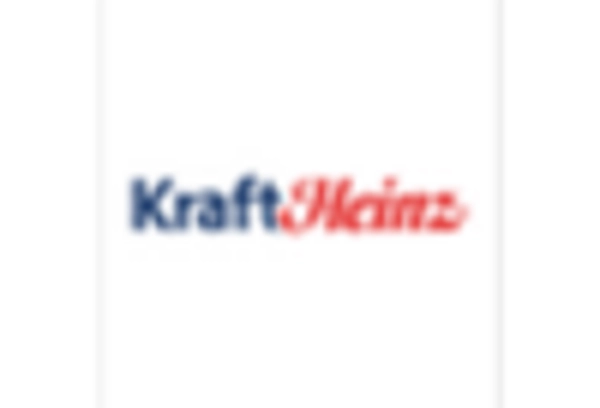Evolving Consumer Lifestyles
Evolving consumer lifestyles significantly influence The Global frozen foods Industry. As urbanization continues to rise, consumers increasingly seek convenient meal solutions that fit their busy schedules. The demand for ready-to-eat and easy-to-prepare frozen meals is surging, with market analysts estimating a growth rate of 5% annually in this segment. Additionally, the trend towards smaller households and single-person living arrangements further drives the need for portion-controlled frozen food options. Consumers are also becoming more adventurous, exploring international cuisines available in frozen formats. This shift in lifestyle preferences encourages manufacturers to innovate and expand their product lines, catering to diverse tastes and dietary requirements. Consequently, The Global Frozen Foods Industry is likely to witness a robust expansion as it adapts to the changing dynamics of consumer behavior.
Increased Focus on Food Safety and Quality
Increased focus on food safety and quality is a critical driver for The Global Frozen Foods Industry. Consumers are becoming more discerning about the products they purchase, demanding transparency and high standards in food safety. Regulatory bodies are also tightening guidelines, compelling manufacturers to adhere to stringent quality control measures. This heightened awareness has led to a surge in demand for frozen foods that are certified organic or free from artificial additives. Market data indicates that the organic frozen food segment is expected to grow by 6% annually, reflecting consumer preferences for healthier options. As a result, companies are investing in quality assurance processes and certifications to build trust with consumers. This emphasis on safety and quality not only enhances brand reputation but also contributes to the overall growth of The Global Frozen Foods Industry.
Expansion of Retail Channels and E-commerce
The expansion of retail channels and e-commerce is a pivotal driver for The Global Frozen Foods Industry. With the rise of online shopping, consumers are increasingly purchasing frozen foods through e-commerce platforms. This shift is particularly pronounced among younger demographics who value convenience and variety. Market data indicates that online sales of frozen foods are expected to grow by 8% annually, reflecting changing shopping habits. Retailers are also enhancing their frozen food sections, offering a broader range of products to attract consumers. The integration of advanced logistics and cold chain management ensures that frozen products maintain their quality during transportation. As a result, the accessibility and availability of frozen foods are improving, which is likely to bolster the overall growth of The Global Frozen Foods Industry.
Rising Popularity of Plant-Based Frozen Foods
The rising popularity of plant-based frozen foods is reshaping The Global Frozen Foods Industry. As more consumers adopt vegetarian and vegan diets, the demand for plant-based frozen options is escalating. Market Research Future suggests that the plant-based frozen food segment is projected to grow at a remarkable rate of 7% per year, driven by health trends and environmental concerns. Manufacturers are responding by expanding their product offerings to include a variety of plant-based meals, snacks, and desserts. This trend not only caters to dietary preferences but also aligns with the growing awareness of sustainability and ethical consumption. The introduction of innovative plant-based ingredients and flavors further enhances the appeal of these products. Consequently, The Global Frozen Foods Industry is likely to experience significant growth as it embraces this shift towards plant-based alternatives.
Technological Advancements in Freezing Techniques
Technological advancements in freezing techniques are transforming The Global Frozen Foods Industry. Innovations such as flash freezing and cryogenic freezing enhance the quality and shelf life of frozen products. These methods preserve the nutritional value and taste of food, appealing to health-conscious consumers. The market is projected to grow at a compound annual growth rate of 4.5% from 2025 to 2030, driven by these advancements. As manufacturers adopt state-of-the-art freezing technologies, they can offer a wider variety of products, including organic and gourmet options. This diversification caters to evolving consumer preferences, thereby expanding market reach. Furthermore, improved freezing techniques reduce food waste, aligning with sustainability goals. Overall, the integration of advanced freezing technologies is likely to play a pivotal role in shaping the future of The Global Frozen Foods Industry.

















